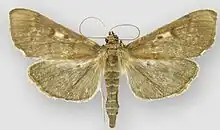| Herpetogramma sphingealis | |
|---|---|
 | |
 | |
| Male (top) and female (bottom) | |
| Scientific classification | |
| Domain: | Eukaryota |
| Kingdom: | Animalia |
| Phylum: | Arthropoda |
| Class: | Insecta |
| Order: | Lepidoptera |
| Family: | Crambidae |
| Genus: | Herpetogramma |
| Species: | H. sphingealis |
| Binomial name | |
| Herpetogramma sphingealis L. Handfield & D. Handfield, 2011 | |
Herpetogramma sphingealis is a small species of moth in the family Crambidae. It was described as a new species in 2011.
Taxonomy
Herpetogramma sphingealis was described by Louis Handfield and Daniel Handfield in 2011.[1]
The Latin name sphingealis refers to the sphingid-like appearance of the males.[1]
Description
The underside of the head, thorax and abdomen, including the legs, are pure white, so it is easily spotted when flying towards a light trap.[1]
Imagoes, adult moths, are sexually dimorphic. The wingspan is 34–37 mm for males and 31–34 mm for females. Males are nearly uniform dark brown. The hind-wings are dark brown with a dark discal spot. Females have more apically-squared wings and are less uniformly dark coloured.[1]
Distribution
It is found from southern Quebec southward in eastern United States to Georgia and Louisiana and as far west as Arkansas.[1]
Ecology
Behaviour
The moth is readily attracted to light traps and flies around at the beginning of the night. It is sometimes one of the first species to come to a light trap. Its flight is darting and rapid.[1]
The caterpillars have been recorded feeding on Polystichum acrostichoides and might also feed on other species of ferns. They roll the fronds of their host plant.[1]
Habitat
It occurs in the darkest areas of rich xeric forests, with maples and oaks, especially rocky, hilly, maple groves where Christmas fern, Polystichum acrostichoides, commonly occurs. With its dark-brown colour the moth is cryptically coloured in its natural habitat and well adapted to hide in the darkest shadows of the woods.[1]
References